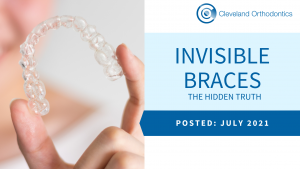Gone are the days when metal braces were the only option available to the dentist for fixing misaligned teeth. Despite their unaesthetic metallic appearance and inconvenience, orthodontic patients had no other choice. But today, more comfortable and aesthetically pleasing options – the so-called invisible braces – are available. If you are also thinking about getting your teeth straightened with invisible braces, you might be wondering whether they are as effective as conventional braces. This article offers everything you need to know about different types of invisible aligners so that you can make an informed decision regarding your orthodontic treatment.
What Are The Options For Invisible Braces?
Orthodontists use different types of invisible braces to treat tooth misalignment. The most commonly used among them include the Invisalign aligners, ceramic, and lingual braces.
- Invisalign Aligners – this system is based on removable aligners made from a transparent polymer, making them virtually invisible when you wear them. Your dentist will give you multiple sets of numbered aligners, one for each jaw. You will be asked to wear each set for at least 22 hours each day for 14 days. Afterwards, you should switch to the next set of aligners. In this way, each set of aligners will gradually move your teeth in the desired direction.
- Ceramic/ Tooth Coloured Braces – these braces are similar in design to the traditional metal braces. However, they are coated with a white material to make them tooth coloured. Even the orthodontic wires are white-coated to make them less conspicuous. Like metal braces, the tension in the wires of the ceramic braces moves the teeth into optimal occlusion and alignment.
- Lingual Braces – Lingual braces have the same design and shape as the traditional metal braces. Despite being made from metal alloys, these braces are called invisible as they are attached to the inner – or the lingual – surfaces of the teeth, which makes them invisible.
Which Type Of Dental Braces Are Most Suitable? (Talk About Different Treatments And Different Systems)
The type of orthodontic system that is most suitable for you depends on your orthodontic treatment needs. For example, the fixed ceramic and lingual braces might be more helpful in treating more complex or complicated problems that involve the bite. On the other hand, if comfort and convenience are desired during treatment, the Invisalign aligners are the best option. Your orthodontist can advise you regarding an option that best suits your dental needs after a thorough clinical examination.
What Are The Disadvantages Of Lingual Braces?
One of the most significant disadvantages of lingual braces is the limited space left in the mouth after their attachment. Not only do they create a hindrance in tongue movement – causing speech difficulties – but the sharp edges of the orthodontic brackets can injure the tongue as well. Furthermore, oral hygiene maintenance often becomes difficult as it is very hard to optimally clean the inner surfaces of the teeth. That is why dentists recommend using an interdental brush along with dental floss or Waterpik to ensure optimal tooth cleaning when wearing lingual braces.
Is Invisalign Really Better Than Braces?
Each orthodontic system has its own merits and demerits. If we talk about comfort and convenience, Invisalign aligners are much better than the traditional, lingual and ceramic braces. On the other hand, braces are a better option for treating moderate to complex orthodontic problems. So, it all depends on your treatment needs.
Invisalign Treatment Plan Template
Orthodontists use a pre-defined guide for the treatment of mild to moderate problems with Invisalign. This template or guide details the steps that will be taken to bring your teeth into optimal alignment. However, depending on your specific orthodontic treatment needs, your orthodontist may modify the template to prepare a customised treatment plan.
Fixed Braces Versus Invisalign
While both Invisalign and metal braces are effective at straightening teeth, both work differently. While the metal braces remain attached to the teeth, Invisalign aligners can be easily removed for eating, brushing and flossing. Another difference is that Invisalign aligners are virtually invisible when worn, in contrast to the highly conspicuous metal braces. Finally, Invisalign and metal braces also differ in terms of their treatment times and cost. Treatment with metal braces is less expensive than clear removable aligners.
What Type Of Braces Are The Fastest
The time required for treating an orthodontic problem depends on various factors, such as the severity of the problem and patient compliance. It also depends on the type of orthodontic system used for the treatment. In the case of mild orthodontic issues, you can expect rapid results with the Invisalign aligners. However, when it comes to more complex problems with an imbalanced bite, then the fastest results can be expected with the fixed metal, ceramic or lingual braces.
The speed of your treatment also depends on the skill and expertise of your orthodontist. The more skilled your dentist or orthodontist is, the lesser time they will take in fixing your problem. If you are looking for a qualified and highly experienced orthodontist in Middlesbrough, look no more. At Cleveland Orthodontics, we have the clinical expertise and state-of-the-art diagnostic and therapeutic equipment to take care of even the most complicated and complex orthodontic problems. We offer all orthodontic services under one roof, whether you need clear aligners, lingual or ceramic braces, or traditional metal braces. So, request a consultation appointment with us today and let us give you a healthy, lasting, and beautiful smile – and a pair of perfectly aligned, pearly-white teeth.




